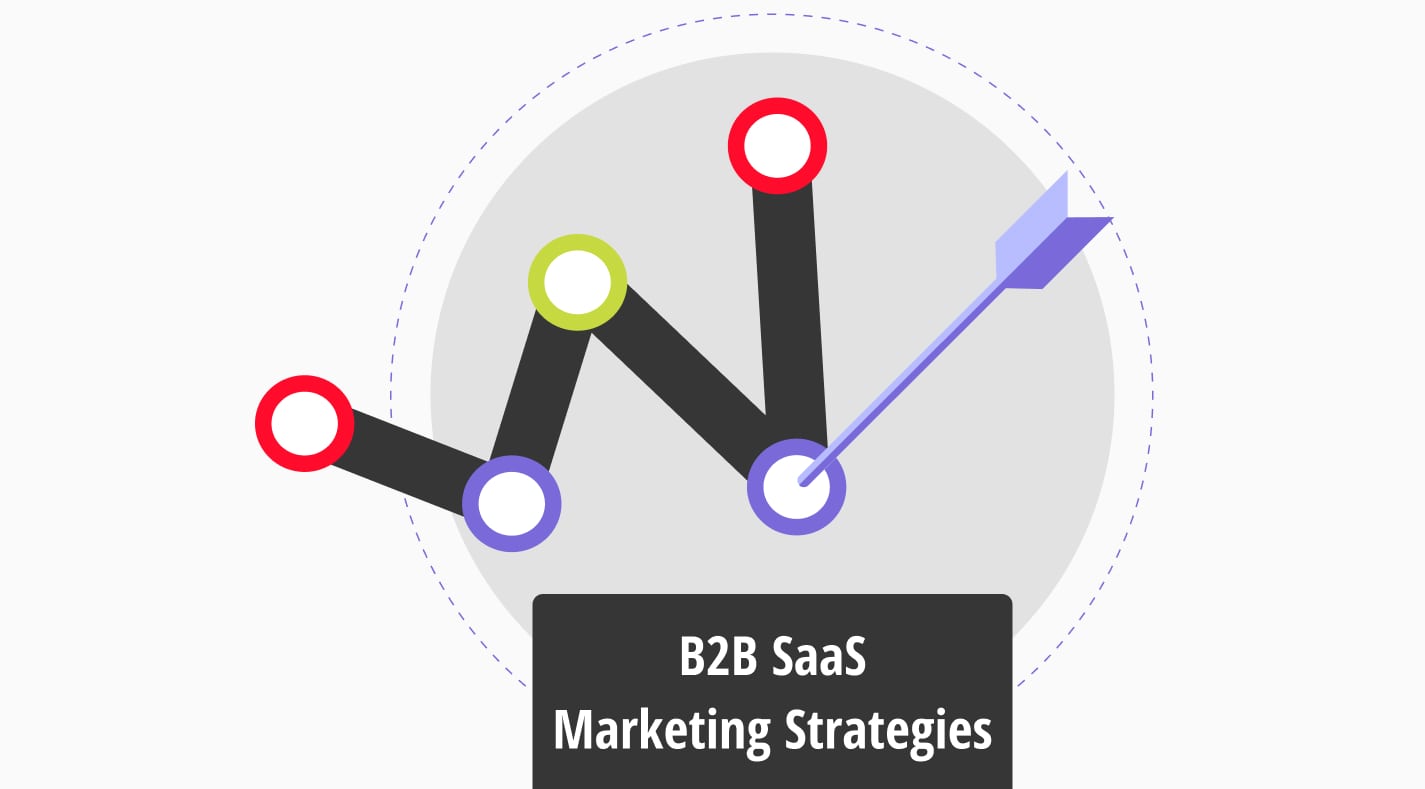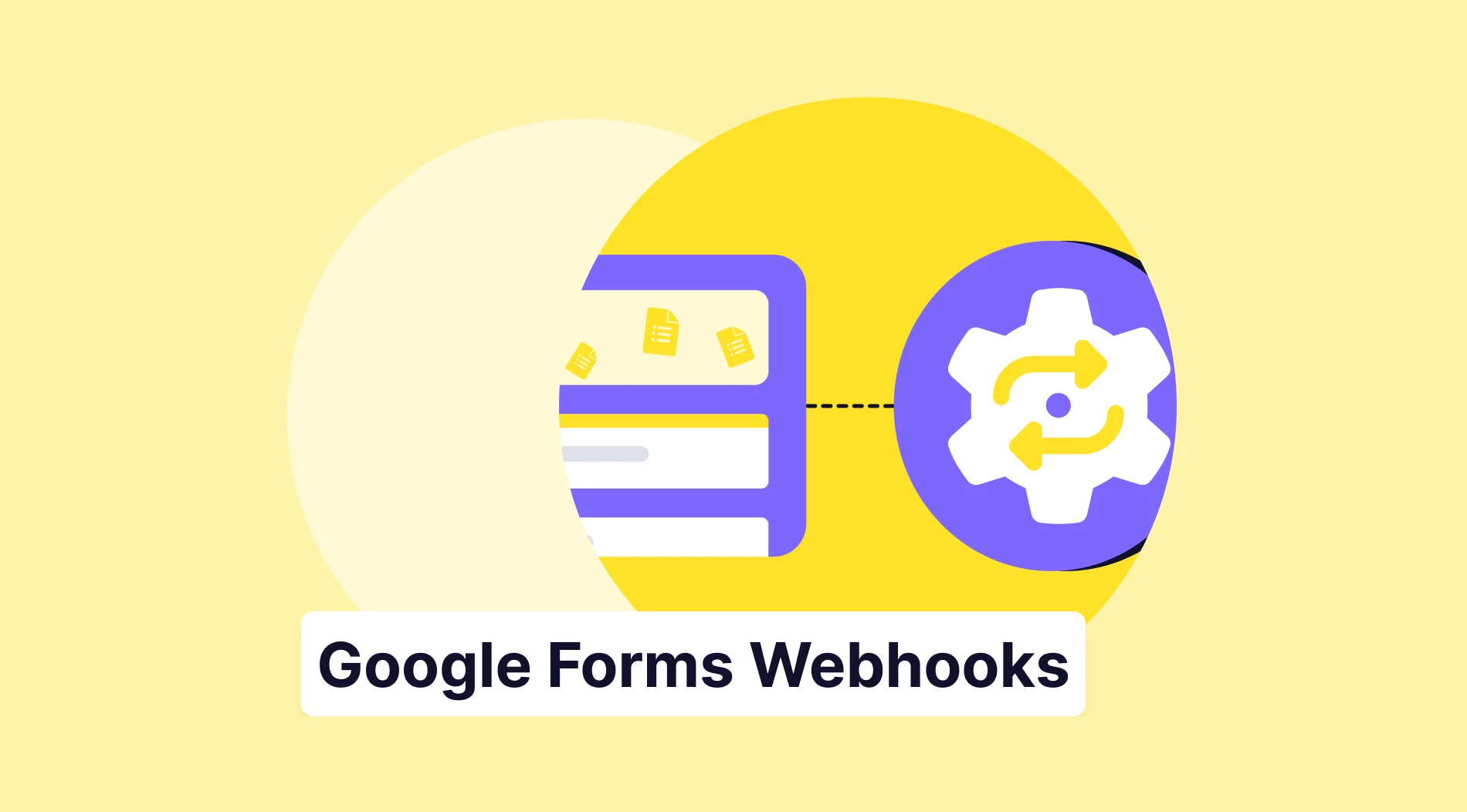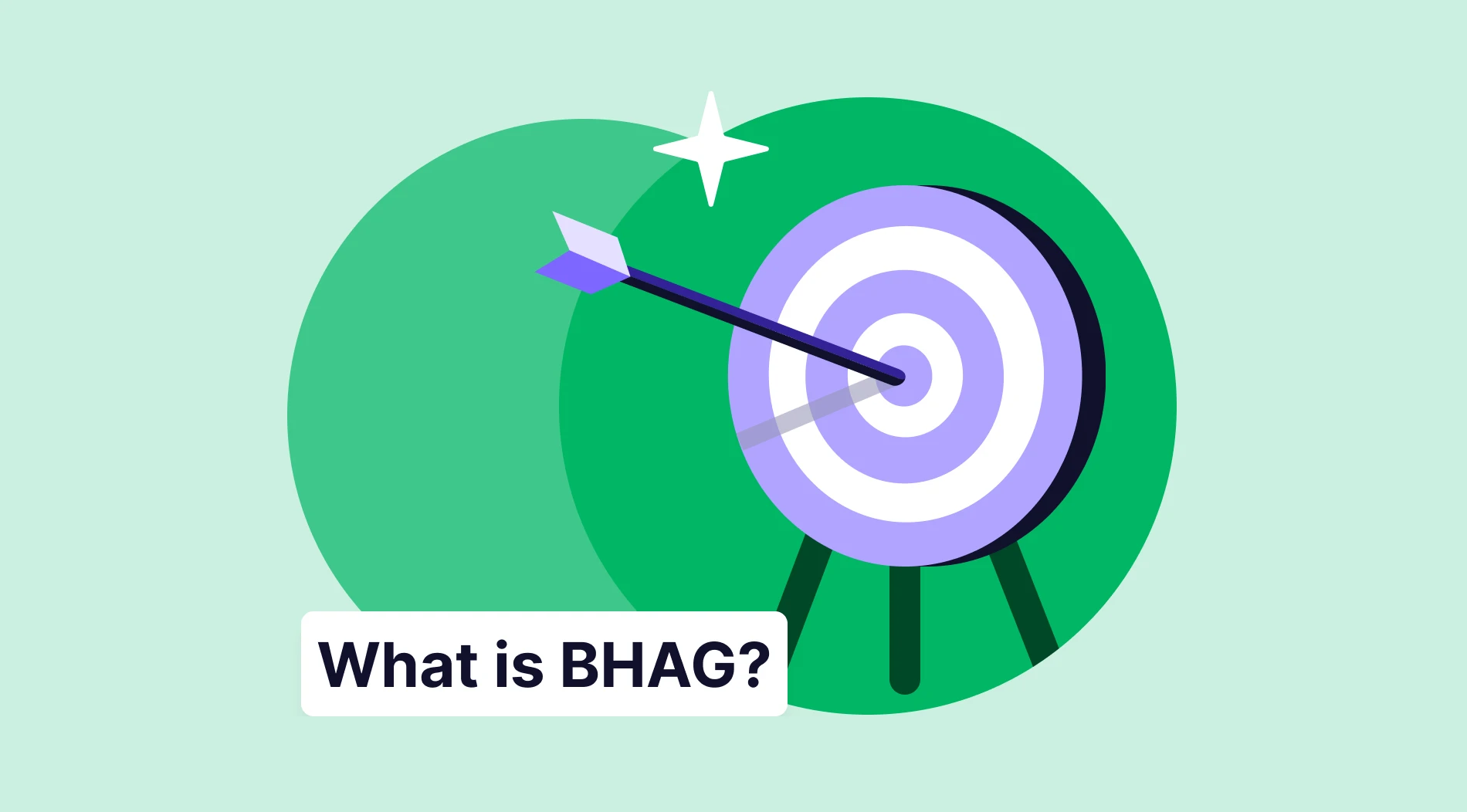The -aaS (-as-a-Service) model has undergone sea changes over the last decade or so. DaaS, KaaS, VDaaS, and so much more are available today. Most B2B marketers must have come across the Pizza-as-a-Service infographics that beautifully outlined the -aaS scenario. The final frontier of that -aaS model is Software-as-a-Service or SaaS.
Crafting effective marketing strategies is essential for the success of any B2B product. This article speaks about the best B2B SaaS marketing strategies, providing insights and actionable tips to elevate your brand, drive engagement, and boost conversions. Whether you're a startup or an established player, these strategies are designed to optimize your SaaS marketing efforts and achieve sustainable growth.
Understanding B2B SaaS marketing
Understanding B2B SaaS marketing involves grasping how businesses sell software solutions to other businesses. It is about identifying and engaging the right decision-makers, emphasizing value and ROI, and utilizing both online and offline channels to nurture leads and foster relationships.
Defining B2B SaaS marketing
B2B SaaS marketing is the strategic promotion of cloud-based software solutions to businesses rather than individual consumers.
This approach focuses on understanding the unique needs, challenges, and decision-making processes of businesses in various industries and tailoring marketing efforts to address those specific points.
Key differences between B2B and B2C SaaS marketing
The fundamental distinction lies in the target audience and their buying journey. B2B buyers seek efficiency, scalability, and ROI, requiring detailed information and often a longer sales cycle. B2C consumers, on the other hand, prioritize ease of use, cost, and immediate benefits, leading to quicker decision-making processes.
Importance of a dual approach (inbound & outbound)
The dual approach has various important points to boost your business’ success, regardless to say. If you are wondering about its importance, we have gathered some under this title. Here’s what a dual approach can offer SaaS marketers:
- Combining inbound and outbound strategies ensures a comprehensive reach.
- Inbound marketing attracts customers with valuable content and interactions, building trust and establishing your brand as a thought leader.
- Outbound marketing complements the above by proactively reaching out to potential customers through various channels, ensuring your solution is considered by decision-makers.
Inbound marketing strategies for B2B SaaS
Inbound marketing strategies for B2B SaaS focus on attracting customers through relevant and helpful content, engaging with them using tailored communications, and delighting them by providing solutions that meet their needs and expectations. This approach leverages various digital marketing tactics to create a holistic strategy that draws potential clients to your company naturally.
Here's an elaboration on each aspect of inbound marketing strategies for B2B SaaS:
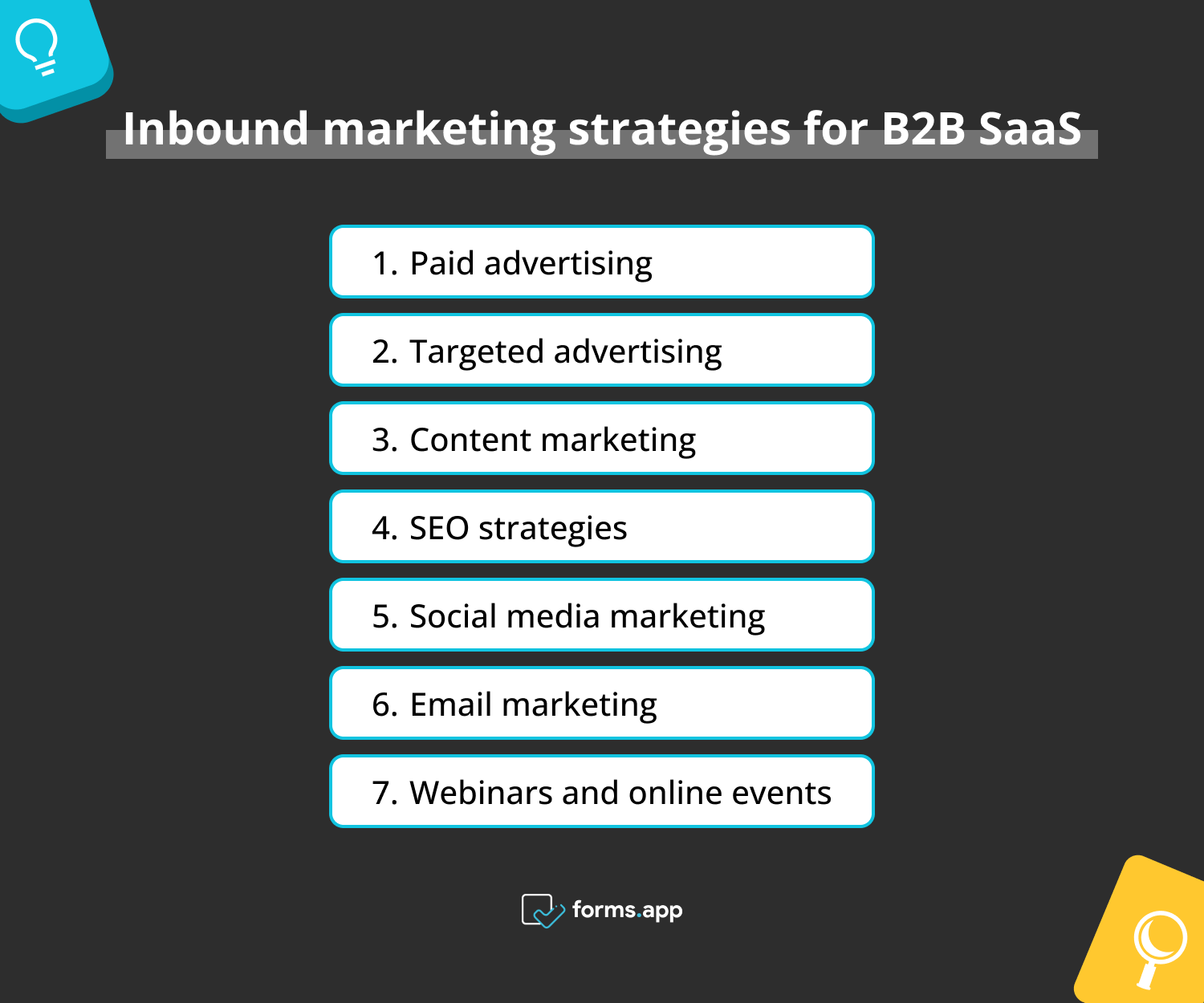
B2B SaaS strategies for inbound marketing
1. Paid advertising
Paid advertising involves a strategic approach used by businesses to reach their target audience more efficiently. By purchasing ad space on various platforms such as search engines, social media, and websites, companies can prominently display their message, ensuring higher visibility and potentially increasing their customer base and sales.
A. PPC campaigns
Pay-per-click (PPC) advertising, especially on platforms like Google Ads and LinkedIn Ads, is highly effective for B2B SaaS. Google Ads work well for keywords, while LinkedIn Ads deliver segmentation based on job functions and industries. This precision ensures your marketing budget is spent on reaching the most relevant audience.
Continuously optimize these campaigns by refining keyword selections, ad copy, and landing pages based on performance analytics to maximize effectiveness.
B. Retargeting strategies
Retargeting or remarketing campaigns are crucial for keeping your brand in mind for potential customers who have already shown interest in your product but have yet to convert. By targeting these individuals with tailored ads across different platforms, including social media and other websites they visit, you can increase the likelihood of converting them into customers.
Effective retargeting involves segmenting your audience based on their interaction level and tailoring messages accordingly.
2. Targeted advertising
Targeted advertising leverages data analysis and user behavior insights to present ads to specific audience segments. Focusing on consumers' interests, demographics, and online activities enhances ad relevance and effectiveness, significantly improving engagement rates and ROI for businesses.
This precision marketing approach ensures advertisers reach their ideal customers more efficiently. Targeted advertising can be an effective outbound tool for B2B SaaS companies. This includes:
A. Display/native ads: Target specific industries, companies, or job titles through platforms like LinkedIn or industry-specific websites.
B. Sponsored content: Pay to feature articles, case studies, or videos on platforms frequented by your target audience.
3. Content marketing
Content marketing is a strategic approach focused on creating and distributing valuable, relevant, and consistent content to attract and retain a clearly defined audience. Its goal is to drive profitable customer action by establishing authority, building trust, and nurturing relationships with potential and existing customers through various forms of media.
Creating and distributing valuable, relevant, and consistent content attracts and retains a clearly defined audience. For B2B SaaS, this means:
A. Blogging: Launching your blog posts that solve everyday problems or answer questions your target audience might have. This helps with SEO and establishes your brand as a thought leader in the industry.
B. Whitepapers and ebooks: These provide detailed insights or solutions to specific industry challenges. Often gated, they are excellent for generating leads as they require users to provide their contact information in exchange for access.
C. Case studies: Demonstrating how your product has helped other businesses through detailed case studies can significantly influence decision-makers by showcasing tangible results and ROI.
4. SEO strategies
Effective SEO strategies encompass a blend of keyword research, quality content creation, on-page optimization, backlink acquisition, and a strong focus on mobile optimization and user experience. Incorporating technical SEO, local SEO, and regular performance analysis ensures a holistic approach, driving organic traffic and improving search engine rankings. For B2B SaaS, this involves:
A. Keyword research: Identifying the terms and phrases your target audience uses when searching for solutions to their problems. The focus should be on long-tail keywords that indicate a higher intent to buy or subscribe.
B. On-page SEO: Optimizing your website content and structure for search engines, including meta tags, headings, and internal linking strategies. As the number of mobile-first businesses continues to rise, it’s imperative that your website is mobile-optimized.
C. Off-page SEO: Building backlinks from reputable sites in your industry to increase your site's authority and search rankings.
D. Local SEO: For SaaS companies targeting specific geographic areas, local SEO can help increase visibility among local businesses.
5. Social media marketing
Social media marketing leverages platforms like Facebook, Instagram, and Twitter to engage audiences, build brand awareness, and drive sales. It involves creating and sharing content, including posts, videos, and ads, tailored to specific target demographics, fostering community interaction, and analyzing data to refine strategies and boost return on investment.
Choosing the right platforms is essential for engaging with a B2B audience effectively. LinkedIn, for instance, is particularly valuable for B2B SaaS due to its professional focus. Strategies include:
A. Content sharing: Regularly posting articles, insights, and company news to keep your audience engaged and informed.
B. Community engagement: Participating in industry-specific groups and discussions can increase your visibility and establish your expertise.
C. Social listening: Monitoring mentions of your brand and industry trends to better understand your audience's needs and preferences.
6. Email marketing
Email marketing is a powerful digital strategy that involves sending emails to prospects and customers. Effective email marketing can convert prospects into customers and turn one-time buyers into loyal fans.
It allows businesses to keep their audience engaged, promote sales, and deliver targeted content, fostering a direct and personalized connection. Email marketing involves more than just sending out newsletters. It includes:
A. List segmentation: Dividing your email list into smaller segments based on criteria such as industry, company size, or engagement level allows for more personalized and relevant communications.
B. Lead nurturing: Designing email sequences that guide potential customers through the buying journey, providing them with valuable information and resources at each stage.
C. Automation: Using email marketing tools to automate parts of the communication process, ensuring timely and consistent contact with your leads.
7. Webinars and online events
Webinars and online events have emerged as engaging tools for digital engagement, allowing businesses and educators to connect with audiences globally. These virtual gatherings facilitate interactive learning, networking, and knowledge sharing, leveraging technology to transcend geographical barriers and create dynamic, accessible platforms for information exchange and community building. Strategies include:
A. Educational content: Focus on providing valuable information that addresses common challenges your target audience faces rather than making these events a sales pitch.
B. Guest speakers: Inviting industry experts or happy customers to speak at your events can increase attendance and credibility.
C. Promotion: Utilizing your website, social media, email lists, and even paid advertising to promote your events and increase registrations. You can use online form builder apps like forms.app to create surveys and forms for webinars and events.
Outbound Marketing Strategies for B2B SaaS
Outbound marketing strategies for B2B SaaS involve proactive efforts to reach potential customers through various channels. Unlike inbound marketing, which focuses on attracting customers through content they seek out themselves, outbound marketing seeks to initiate the conversation.
Before reaching out to potential customers, we must clearly understand who your ideal customers are, their needs, and interests. Here's a detailed look at several effective outbound marketing strategies for B2B SaaS companies:
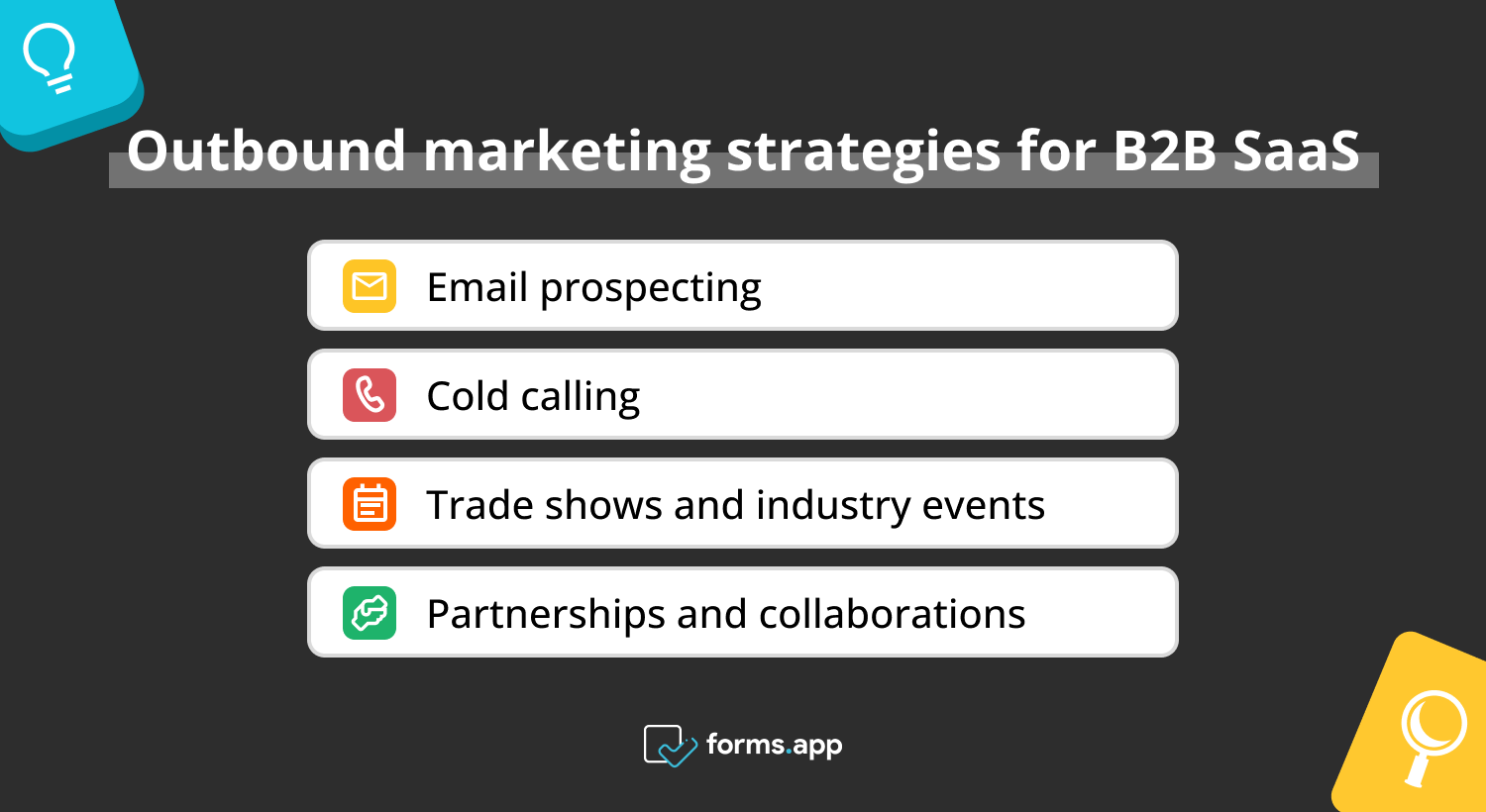
B2B SaaS marketing strategies for outbound marketing
1. Email prospecting
This strategy involves sending personalized emails to potential leads. It is crucial to research and segment your target audience to tailor your message to their specific needs, challenges, and industry trends. The goal is to provide value in your communication, whether through insights, offers, or solutions that address their pain points.
Tools like CRM software can help manage and automate this process, allowing for tracking and optimizing campaigns based on open rates, response rates, and conversion rates. Personalizing your messages for prospects can increase the chances of getting a response.
Use their name, company name, and other relevant details to show that you have done your research. Keep your message short, clear, and engaging. Highlight the benefits of your products or services, and include a clear call-to-action.
2. Cold calling
While often considered a traditional approach, cold calling can be highly effective when combined with modern sales intelligence tools. These tools provide insights into potential leads, such as their recent business activities, enabling more personalized and timely conversations.
The key is to approach calls to help rather than sell, focusing on understanding the prospect's challenges and suggesting ways your SaaS solution can help. Keep trying and follow up with prospects after a few days or a week to increase your chances of getting a response.
3. LinkedIn outreach
As a social platform for businesses, LinkedIn has only grown in popularity over the years. While cold calling or cold emails still work today, LinkedIn outreach offers a faster and easier approach.LinkedIn outreach can be done manually or automatically via LinkedIn automation tools. Depending on the scale of your campaign, you can choose either one. Manual labor will make sure every message from you is personalized for the receiver; however, by using automation thoughtfully, you can foster genuine connections without sacrificing authenticity."
4. Trade shows and industry events
Participating in trade shows and industry-specific events can increase your brand's visibility and credibility. These events allow you to engage with potential customers, demonstrate your product, and collect direct feedback. To maximize ROI:
A. Pre-event marketing: Use your website, social media, and email marketing to announce your participation and invite potential leads to meet you at the event. Select the communication channels your target audience uses frequently, such as email, social media, or phone.
B. At the event: Ensure your booth is engaging and staffed with knowledgeable team members who can effectively communicate the value of your SaaS solution. Live demos, interactive presentations, and free trials are great ways to attract attendees.
C. Post-event follow-up: Collect contact information from booth visitors and event attendees for follow-up communications. Send personalized emails thanking them for their visit, offering further information, or scheduling a demo or meeting to continue the conversation.
5. Partnerships and collaborations
Building partnerships with other companies that serve your target market but are not direct competitors can open up new channels for customer acquisition. This can include:
A. Referral partnerships: Establish agreements with partners to refer clients to each other. This is particularly effective when partners offer complementary services to your SaaS solution.
B. Co-marketing efforts: Collaborate on marketing initiatives such as webinars, joint research reports, or co-branded content. This allows both parties to benefit from the combined audience reach and expertise.
C. Reseller or affiliate programs: Develop programs where partners can resell your SaaS product or earn referral commissions. This expands your sales efforts without significantly increasing your marketing budget.
D. Direct mail: For high-value prospects, consider sending personalized packages or mailers. This approach can stand out in an era dominated by digital communication.
Measuring success and optimization
For each outbound strategy, tracking specific metrics to gauge effectiveness is essential. This might include response rates, meeting set rates, conversion rates, and ROI. Continuous optimization—based on data analysis—is crucial to improving these strategies over time. Experiment with messaging, channels, and offers to see what resonates best with your target audience, and always be prepared to pivot based on results.
Outbound marketing strategies for B2B SaaS require combining traditional techniques and modern tools. By personalizing your outreach, providing value at every interaction, and leveraging data for continuous improvement, your SaaS company can effectively use outbound marketing to attract and convert more customers.
KPIs for B2B SaaS marketing
KPIs, such as lead generation rates, conversion rates, customer acquisition cost, and lifetime value, provide insight into the effectiveness of your marketing efforts. Tracking these metrics over time helps identify successful strategies and areas for improvement.
Tools for measuring marketing effectiveness: Leveraging tools like Google Analytics, CRM software, and marketing automation platforms can help track and analyze performance data, enabling data-driven decisions to optimize your marketing strategies.
Continuous optimization strategies: The key to sustained success in B2B SaaS marketing is continuous optimization. Regularly reviewing campaign performance, staying abreast of industry trends, and being willing to experiment with new strategies can help maintain and grow your market presence.
Emerging trends in B2B SaaS marketing
Emerging trends in B2B SaaS marketing emphasize personalized and value-driven content, leveraging AI for predictive analytics and customer insights. Account-Based Marketing (ABM) is becoming more prevalent, focusing on key accounts for personalized engagement.
Additionally, there's a shift towards leveraging personalization through social media platforms for community building and using interactive content to engage and educate potential customers.
AI and automation in marketing
AI and automation are revolutionizing marketing by enabling personalized customer experiences, optimizing campaign performance, and streamlining operations. These technologies analyze vast data sets to predict trends, automate repetitive tasks, and deliver targeted content, significantly enhancing efficiency and engagement while reducing manual effort and costs in marketing strategies.
1. Account-based marketing (ABM)
Account-based marketing (ABM) is a strategic approach that concentrates marketing resources on a set of target accounts within a market. It employs personalized campaigns designed to engage each account, basing the marketing message on the specific attributes and needs of the account, thus driving more relevant and effective marketing outcomes.
2. Personalization and user experience
Personalizing the user experience at every touchpoint in an increasingly crowded SaaS market can differentiate your brand. Tailoring the content, recommendations, and interactions based on individual user behavior and preferences can significantly enhance customer satisfaction and loyalty. Slowly but surely, it will be all about the hyper-personalization of user experiences.
Conclusion
The B2B SaaS outlook in 2024 demands a holistic and adaptable approach to marketing. Businesses can build meaningful relationships with their target audience by understanding the unique challenges and opportunities within B2B SaaS and implementing a balanced mix of inbound and outbound strategies.
Staying informed about emerging trends and continuously optimizing your marketing efforts will be vital to achieving long-term success in the ever-evolving world of B2B SaaS.
Sena is a content writer at forms.app. She likes to read and write articles on different topics. Sena also likes to learn about different cultures and travel. She likes to study and learn different languages. Her specialty is linguistics, surveys, survey questions, and sampling methods.
- Understanding B2B SaaS marketing
- Importance of a dual approach (inbound & outbound)
- Inbound marketing strategies for B2B SaaS
- Outbound Marketing Strategies for B2B SaaS
- Measuring success and optimization
- KPIs for B2B SaaS marketing
- Emerging trends in B2B SaaS marketing
- AI and automation in marketing
- Conclusion
